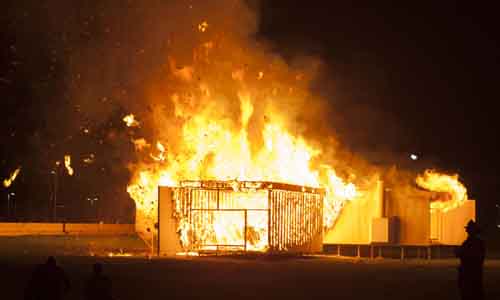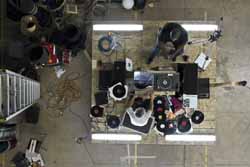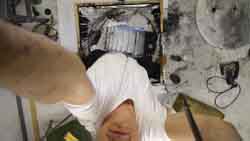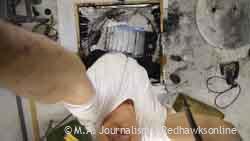Q&A with Chris Larson (’85), local Twin Cities artist and professor of art at the U of M
The Talon: You are currently working on an architectural project to build a clinic in Kenya. How did you get involved with this?
Chris Larson: This project is an unlikely collaboration with a friend of mine Michael Kimpur, a tribal elder in rural Kenya and Director of Daylight Center School in Kapenguria Kenya. In 2013, I rebuilt a full-size replica of a St. Paul Minnesota Marcel Breuer Modernist house and burned it down in front of 25,000 people. It was covered  in a feature article in the New York Times. After a year of conv
in a feature article in the New York Times. After a year of conv ersations with Michael Kimpur and hearing the needs of this rural community, we came up with the radical idea of relocating and rebuilding the St. Paul Marcel Breuer house on the Daylight property. Not to burn it down, but to use it as a clinic for the children at Daylight and the surrounding community. Daylight Center and School strives to empower the nomadic communities to realize a peaceful future for themselves. They believe that children are the key to breaking long-standing generational patterns of violent behavior. I am thrilled to be working on this project with Michael.
ersations with Michael Kimpur and hearing the needs of this rural community, we came up with the radical idea of relocating and rebuilding the St. Paul Marcel Breuer house on the Daylight property. Not to burn it down, but to use it as a clinic for the children at Daylight and the surrounding community. Daylight Center and School strives to empower the nomadic communities to realize a peaceful future for themselves. They believe that children are the key to breaking long-standing generational patterns of violent behavior. I am thrilled to be working on this project with Michael.
In your project, one main goal is to bring art to Africa, while building a house as well. Why is incorporating art so important?
In 2014, I received a fellowship from the University of Minnesota where I am a professor in the department of Art. I’m using the funds from the fellowship to film and document the building of the Marcel Breuer house in rural Kenya. That’s the art in this project.
What significance did burning the first Breuer replica carry?
Burning the Breuer replica at the Northern Spark Festival was not an act of mourning. Rather than a funeral pyre, it represents hope. Ruinous beauty burns to reveal new possibility-seeing through the high point of man-made perfection to the potentialities wrought through its destruction. The burned house persists not as a blank page but as an erased page, a way to begin again. Architects always glean hope from ruination-to build on old foundations but to build anew. Value is in the fire, the spectacle of
ruin, and the release of potentiality. Therein resides hope. The hope is now being realized in northern Kenya.
Can you talk about your exhibition titled “The Raft” in New York?
 “The Raft” was a multi-channel video installation collaborative project with Brooklyn based artist Rico Gatson. Rico and I have been friends and colleagues for almost 30 years. This video project is loosely based on the novel The Adventures of Huckleberry Finn. Together we performed on top of a moveable platform measuring ten feet square. Surrounded by various detritus we played records from our personal collection spanning the legacy of popular music. The role of music has played an important and instrumental role in both of our lives, both studio practice and relationship. The setting of the video was in my studio located in St. Paul, Minnesota. The studio is traditionally seen as a sacred space, the place where ideas are generated and the work is created. We saw this location as essential to re-envisioning aspects of The Adventures of Huckleberry Finn. This project was on view in 2015 at a gallery called “The Boiler” located in Brooklyn, New York.
“The Raft” was a multi-channel video installation collaborative project with Brooklyn based artist Rico Gatson. Rico and I have been friends and colleagues for almost 30 years. This video project is loosely based on the novel The Adventures of Huckleberry Finn. Together we performed on top of a moveable platform measuring ten feet square. Surrounded by various detritus we played records from our personal collection spanning the legacy of popular music. The role of music has played an important and instrumental role in both of our lives, both studio practice and relationship. The setting of the video was in my studio located in St. Paul, Minnesota. The studio is traditionally seen as a sacred space, the place where ideas are generated and the work is created. We saw this location as essential to re-envisioning aspects of The Adventures of Huckleberry Finn. This project was on view in 2015 at a gallery called “The Boiler” located in Brooklyn, New York.
I see that the “State of the Art: Discovering American Art Now” opened February 18 at MIA. What work have you done for the MIA and what was your inspiration behind it?
It’s a video projection piece called Heavy Rotation. In 2011, I was invited to do a site visit to a new exhibition space called “The View” in Salenstein, Switzerland for a possible exhibition. The View is a contemporary art space situated in two 100-year-old underground former water reservoirs. As I walked through the reservoir’s  underground, I looked up and saw a circular concrete cap in the ceiling leading to the space above. I then walked on top of the reservoir and found the same concrete cap in the earth. I had this great sensation of being in two places at one time, just through that portal. Inside/outside became one space. On the plane ride back to Minnesota, I made a simple sketch of stacked spaces, maybe 10 of them stacked on top of each other with a hole leading down into the next space, connecting them all simultaneously. When I got back to the studio, I started building the rooms stacked on top of each other with the idea that I would activate the space by drawing on the floor and, through this act of drawing, the floor would disintegrate allowing me to pass through to the next space.”
underground, I looked up and saw a circular concrete cap in the ceiling leading to the space above. I then walked on top of the reservoir and found the same concrete cap in the earth. I had this great sensation of being in two places at one time, just through that portal. Inside/outside became one space. On the plane ride back to Minnesota, I made a simple sketch of stacked spaces, maybe 10 of them stacked on top of each other with a hole leading down into the next space, connecting them all simultaneously. When I got back to the studio, I started building the rooms stacked on top of each other with the idea that I would activate the space by drawing on the floor and, through this act of drawing, the floor would disintegrate allowing me to pass through to the next space.”
Do you have any more upcoming plans?
I have a solo show coming up at the Walker Art Center that opens in June 2016. This new work is a sculpture/video installation called “Land Speed Record,” titled after a 1981 live album by punk band Husker Dü. It’s a 26 minute video that looks at objects left over from a house fire from the childhood home of Husker Dü drummer Grant Hart, a long time friend and collaborator of mine. I also just published new quarterly print publication called “In Review” that just hit the stands in April 2016. It’s dedicated to presenting critical responses and engaging extended conversations about art in the Twin Cities. I’m very excited about my new adventure in publishing!

